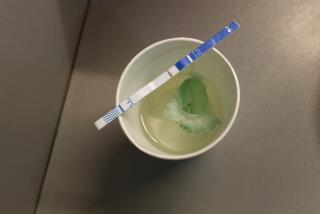Random Drug Tests: Worth the Price?
- Share via
Ever take a train? Or a plane? Or a bus? And, while you were sitting there, did you ever wonder what might happen to you if the people running your train or plane or bus were on drugs?
Ever drive on a road where there were trucks? Sure, you have. But did you ever wonder what might happen to you if that truck that just roared up 6 inches off your rear bumper were being driven by a man on drugs to keep him awake?
Your federal government is wondering, too.
Which is why last week, the government announced its first plans for the mandatory drug testing of people in the private sector. The Department of Transportation ordered the random testing of 4 million workers starting in December, 1989.
The order covers interstate truckers and bus drivers, airline pilots, navigators, flight attendants and mechanics; railroad engineers, brakemen and conductors (who are already subject to limited drug and alcohol testing), subway engineers and bus drivers in mass transit systems, merchant seamen with Coast Guard licenses and pipeline workers who handle natural gas and hazardous liquids.
Mandatory drug testing has been talked about for a long time. And back in September, 1986, when Ronald Reagan first seemed to be getting serious about drug testing for federal employees, I raised some objections.
I wrote back then that the testing of that many people was going to be expensive. And it is. But the cost of drug tests for people in the private sector is going to be paid by the private sector.
The government places the cost of the new drug testing program at $2 billion over 10 years. Private industry and local mass transit are going to have to pay, but the government figures the cost of the program will more than be repaid by the $8.7 billion saved in the same period through a reduction of accidents, absenteeism, medical costs, etc.
I also wrote two years ago that drug tests are far from perfect and show false positives about 10% of the time. They do. Which is why the government will demand a more stringent follow-up test for anyone testing positive.
I also said the tests were intrusive. And in order to ensure that the subjects do not substitute someone else’s urine sample, the subjects must be watched as they deliver the sample to the cup.
Which is not pleasant for the watchee or the watcher. And that is still going to be true.
What the unions and civil liberties groups object to in random drug testing is that reasonable cause is removed. If you have a reason to believe someone is taking drugs, then test, they say. But random testing violates constitutional rights, a matter the Supreme Court will probably decide next spring.
But ask yourself this: How do we learn about reasonable cause? How do we know employees might be on drugs so that we can test them? Answer: We almost never do.
On Jan. 4, 1987, there was a train crash in Chase, Md., in which 16 people died and 175 were injured. Engineer Ricky Gates and brakeman Edward Cromwell both admitted to smoking marijuana shortly before the crash, the deadliest in Amtrak history.
Gates testified before a U.S. Senate panel in February of this year. Drinking and drug use by rail workers is “very accepted practice,” he said.
He cited case after case of workers drinking or using drugs and said that 10% to 20% of all rail employees drink or use drugs while working. (Cromwell estimated it was 40% to 50%.)
But did Gates ever turn anybody in? Did he ever go and say he had “reasonable cause” to believe someone was endangering the lives of passengers and should be tested for drugs?
Of course he didn’t. And you probably wouldn’t turn in a fellow worker either. It violates the unwritten law of the workplace. Workers don’t rat on each other.
“I wouldn’t turn anybody in; I wouldn’t want them to turn me in,” Gates told the Senate panel.
Which is where testing only when we have “reason to suspect” someone was using drugs breaks down. We usually don’t get a reason to suspect someone until after the crash and bodies are strewn over the countryside and people wake up in hospital beds without arms or legs.
Nor is the problem uncommon. Officials say that last year there were 41 railroad accidents in which one or more rail employees tested positive for drugs. Those accidents killed 29 people, injured 341 and caused $28 million in property damage.
How many accidents on the highways are caused by truckers on drugs? How many plane crashes due to the crew on drugs? (In January, a commuter plane crashed in Durango, Tex., killing nine people. The pilot tested positive for cocaine.) How many bus accidents or subway accidents or accidents at sea?
We don’t know for sure. But we do know that people’s lives, our lives, are at risk.
That is what drug testing is all about. Is it the first step toward Big Brother? Maybe. I hope not, but maybe.
What I do know is that lives are at stake. Your life, my life, the lives of our loved ones.
I also know that when we get on a plane or train or bus or we get in a car and go on the highway, we deserve one thing: a fighting chance to stay alive.
And if random drug testing will give us that chance, it’s worth it.
More to Read
Sign up for Essential California
The most important California stories and recommendations in your inbox every morning.
You may occasionally receive promotional content from the Los Angeles Times.










